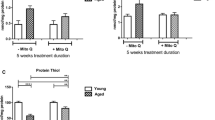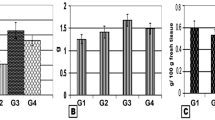Abstract
The present study demonstrated the neuroprotective effect of curcuminoids, the active polyphenols of Curcuma longa (L.) rhizomes on mitochondrial dysfunctioning in middle aged and aged female Wistar rat brain. Rats were orally treated with curcuminoids (100 mg/kg) for 3 months and their brain was collected for evaluation of mitochondrial enzymes and complexes activity, ultra structural changes in mitochondria, neuronal nitric oxide synthase (nNOS) protein expression, adenosine triphosphate (ATP) and lipofuscin content. Significant alterations were observed in all the tested parameters in highly aged rat brain when compared with young control. Long term curcuminoids administration prevented this age associated loss of mitochondrial enzymes and complexes activity in middle aged rat brain except for malate dehydrogenase, Complex II and IV activity when compared with young control. Among aged rats, curcuminoids treatment specifically elevated isocitrate and NADH dehydrogenase, cytochrome c oxidase, Complex I and total ATP content. A significant down-regulation of nNOS protein expression along with reduced lipofuscin content was also observed in curucminoids treated middle aged and aged rats. Thus, it was suggested that curcuminoids may act as a putative drug candidate for the prevention of deleterious effects of ageing and age associated neurodegenerative disorders through amelioration of aberrant mitochondrial functioning.









Similar content being viewed by others
References
Ahmed T, Gilani AH (2009) Inhibitory effect of curcuminoids on acetylcholinesterase activity and attenuation of scopolamine-induced amnesia may explain medicinal use of turmeric in Alzheimer’s disease. Pharmacol Biochem Behav 91(4):554–559
Ahmed T, Gilani AH (2013) Therapeutic potential of turmeric in Alzheimer’s disease: curcumin or curcuminoids? Phytother Res. doi:10.1002/ptr.5030
Aliyev A, Chen SG, Seyidova D, Smith MA, Perry G, de la Torre J, Aliev G (2005) Mitochondria DNA deletions in atherosclerotic hypoperfused brain microvessels as a primary target for the development of Alzheimer’s disease. J Neurol Sci 229–230:285–292
Belviranl M, Okudan N, Atalk KE, Öz M (2013) Curcumin improves spatial memory and decreases oxidative damage in aged female rats. Biogerontology 14(2):187–196
Birch-Machin MA, Briggs HL, Saborido AA, Bindoff LA, Turnbull DM (1994) An evaluation of the measurement of the activities of complexes I–IV in the respiratory chain of human skeletal muscle mitochondria. Biochem Med Metab Biol 51:35–42
Bolanos JP, Almeida A, Stewart V, Peuchen S, Land JM, Clark JB, Heales SJ (1997) Nitric oxide-mediated mitochondrial damage in the brain: mechanisms and implications for neurodegenerative diseases. J Neurochem 68:2227–2240
Braidy N, Grant R, Adams S, Guillemin GJ (2010) Neuroprotective effects of naturally occurring polyphenols on quinolinic acid induced excitotoxicity in human neurons. FEBS J 277(2):368–382
Bubber P, Haroutunian V, Fisch G, Blass JP, Gibson GE (2005) Mitochondrial abnormalities in Alzheimer brain: mechanistic implications. Ann Neurol 57:695–703
Calabrese V, Bates TE, Stella AM (2000) NO synthase and NO dependent signal pathways in brain aging and neurodegenerative disorders: the role of oxidant/antioxidant balance. Neurochem Res 25:1315–1341
Cash AD, Aliev G, Siedlak SL, Nunomura A, Fujioka H, Zhu X, Raina AK, Vinters HV, Tabaton M, Johnson AB, Paula-Barbosa M, Avila J, Jones PK, Castellani RJ, Smith MA, Perry G (2003) Microtubule reduction in Alzheimer’s disease and aging is independent of tau filament formation. Am J Pathol 162:1623–1627
Chuang YC, Tsai JL, Chang AY, Chan JY, Liou CW, Chan SH (2002) Dysfunction of the mitochondrial respiratory chain in the rostral ventrolateral medulla during experimental endotoxemia in the rat. J Biomed Sci 9:542–548
Crouch PJ, Cimdins K, Duce JA, Bush AI, Trounce IA (2007) Mitochondria in aging and Alzheimer’s disease. Rejuvenation Res. 10:349–357
Czerniczyniec A, Bustamante J, Arnaiz SL (2006) Modulation of brain mitochondrial function by deprenyl. Neurochem Int 48:235–241
Davey GP, Peuchen S, Clark JB (1998) Energy thresholds in brain mitochondria. Potential involvement in neurodegeneration. J Biol Chem 273:12753–12757
Demirovic D, Rattan SI (2011) Curcumin induces stress response and hormetically modulates wound healing ability of human skin fibroblasts undergoing ageing in vitro. Biogerontology 12(5):437–444
Elfering SL, Sarkela TM, Giulivi C (2002) Biochemistry of mitochondrial nitric-oxide synthase. J Biol Chem 277(41):38079–38086
Frasca JM, Parks VR (1960) A routine technique for double staining ultrathin sections using uranyl and lead salts. J Cell Biol 25:157
Garcia-Ruiz C, Collel A, Morales A (1995) Role of oxidative stress generated from the mitochondrial transport chain and mitochondrial GSH status in loss of mitochondrial function and activation of transcription factor NF-κB. Studies with isolated mitochondria and rats hepatocytes. Mol Pharmacol 48:825–834
Gibson SL, Hilf R (1983) Photosensitization of mitochondrial cytochrome c oxidase by hemato-porphyrin derivative and related porphyrins, in vitro and in vivo. Cancer Res 43:4191–4197
Gibson GE, Sheu KFR, Blass JP (1998) Abnormalities of mitochondrial enzymes in Alzheimer disease. J Neural Transm 105(8–9):855–870
Haripriya D, Anusuya Devi M, Kokilavani V, Sangeetha P, Panneerselvam C (2004) Age-dependent alterations in mitochondrial enzymes in cortex, striatum and hippocampus of rat brain—potential role of l-Carnitine. Biogerontology 5:355–364
Haycock JW, Jones P, Harris JB, Mantle D (1996) Differential susceptibility of human skeletal muscle proteins to free radical induced oxidative damage: a histochemical, immunocytochemical and electron microscopical study in vitro. Acta Neuropathol 92:331–340
Hinerfeld D, Traini MD, Weinberger RP, Cochran B, Doctrow SR, Harry J, Melov S (2004) Endogenous mitochondrial oxidative stress: neurodegeneration, proteomic analysis, specific respiratory chain defects, and efficacious antioxidant therapy in superoxide dismutase 2 null mice. J Neurochem 88:657–667
Jesko H, Chalimoniuk M, Strosznajder JB (2003) Activation of constitutive nitric oxide synthase(s) and absence of inducible isoform in aged rat brain. Neurochem Int 42:315–322
Kwong LK, Sohal RS (2000) Age-related changes in activities of mitochondrial electron transport complexes in various tissues of the mouse. Arch Biochem Biophys 373(1):16–22
McCann SM, Licinio J, Wong ML, Yu WH, Karanth S, Rettori V (1998) The nitric oxide hypothesis of aging. Exp Gerontol 33:813–826
Michikawa Y, Mazzucchelli F, Bresolin N, Scarlato G, Attardi G (1999) Aging-dependent large accumulation of point mutations in the human mtDNA control region for replication. Science 286:774–779
Murray J, Taylor SW, Zhang B, Ghosh SS, Capaldi RA (2003) Oxidative damage to mitochondrial complex I due to peroxynitrite: identification of reactive tyrosines by mass spectrometry. J Biol Chem 278(39):37223–37230
Mythri RB, Jagatha B, Pradhan N, Andersen J, Bharath MM (2007) Mitochondrial complex I inhibition in Parkinson’s disease: how can curcumin protect mitochondria? Antioxid Redox Signal 9(3):399–408
Navarro A, Boveris A (2004) Rat brain and liver mitochondria develop oxidative stress and lose enzymatic activities on aging. Am J Physiol Regul Integr Comp Physiol 287:R1244–R1249
Navarro A, Boveris A (2005) Rat brain and liver mitochondria develop oxidative stress and lose enzymatic activities on aging. Am J Physiol Regul Integr Comp Physiol 287:R1244–R1249
Navarro A, Boveris A (2007) The mitochondrial energy transduction system and the aging process. Am J Physiol Cell Physiol 292:C670–C686
Obrenovich ME, Smith MA, Siedlak SL, Chen SG, de la Torre JC, Perry G, Aliev G (2006) Overexpression of GRK2 in Alzheimer disease and in a chronic hypoperfusion rat model is an early marker of brain mitochondrial lesions. Neurotox Res 10(1):43–56
Ojaimi J, Masters CL, Opeskin K, McKelvie P, Byrne E (1999) Mitochondrial respiratory chain activity in the human brain as a function of age. Mech Ageing Dev 111:39–47
Parihar MS, Parihar A, Villamena FA, Vaccaro PS, Ghafourifar P (2008) Inactivation of mitochondrial respiratory chain complex I leads mitochondrial nitric oxide synthase to become pro-oxidative. Biochem Biophys Res Commun 367:761–767
Rastogi M, Ojha RP, Rajamanickam GV, Agrawal A, Aggarwal A, Dubey GP (2008) Curcuminoids modulates oxidative damage and mitochondrial dysfunction in diabetic rat brain. Free Radical Res 11(2):999–1005
Remus JC, Firman JD (1995) Effect of thiamine deficiency on energy metabolites in the Turkey. J Nutr Biochem 6:636–639
Sastre J, Millan A, dl Garcia A, Pla R, Juan G, O’Connor EP, Martin JA, Droy-Lefaix MT, Vina J (1998) A Ginkgo biloba extract (EGb 761) prevents mitochondrial aging by protecting against oxidative stress. Free Radic Biol Med 24:298–304
Schipper HM (2011) Heme oxygenase-1 in Alzheimer disease: a tribute to Moussa Youdim. J Neural Transm 118:381–387
Sharma D, Sethi P, Hussain E, Singh R (2009) Curcumin counteracts the aluminium-induced ageing-related alterations in oxidative stress, Na+, K+ ATPase and protein kinase C in adult and old rat brain regions. Biogerontology 10(4):489–502
Shi Q, Hui X, Deng H, Yu H, Je Y, Estevez AG, Gibson GE (2011) Inactivation and reactivation of the mitochondrial α-ketoglutarate dehydrogenase complex. J Biol Chem 286(20):17640–17648
Shults CW, Nasirian F, Ward DM, Nakano K, Pay M, Hill LR, Haas RH (1995) Carbidopa: levodopa and selegiline do not affect platelet mitochondrial function in early Parkinsonism. Neurology 45:344–348
Sood PK, Nahar U, Nehru B (2011) Curcumin attenuates aluminium induced oxidative stress and mitochondrial dysfunction in rat brain. Neurotox Res 20(4):351–361
Sudheesh NP, Ajith TA, Janardhanan KK (2009) Ganoderma lucidum (Fr.) P. Karst enhances activities of heart mitochondrial enzymes and respiratory chain complexes in the aged rat. Biogerontology 10(5):627–636
Takasawa M, Hayakawa M, Sugiyama S, Hattori K, Ito T, Ozawa T (1993) Age-associated damage in mitochondrial function in rat hearts. Exp Gerontol 28:269–280
Tekkanat KK, Fox IH (1988) Isocratic separation of ATP and its degradation products from biological fluids by automated liquid chromatography. Clin Chem 3415:925–932
Wakabayashi T (2002) Megamitochondria formation—physiology and pathology. J Cell Mol Med 6:497–538
Wang K, Qiu F (2013) Curcuminoid metabolism and its contribution to the pharmacological effects. Curr Drug Metab 14(7):791–806
Wilhelm J, Herget J (1999) Hypoxia induces free radical damage to rat erythrocytes and spleen: analysis of the fluorescent end-products of lipid peroxidation. Int J Biochem Cell Biol 31:671–681
Yan LJ, Levine RL, Sohal RS (1997) Oxidative damage during aging targets mitochondrial aconitase. Proc Natl Acad Sci USA 94:11168–11172
Acknowledgments
We acknowledge Dr. S. K. Shankar, Former Head, Department of Neuropathology, NIMHANS for granting permission to perform TEM analysis.
Author information
Authors and Affiliations
Corresponding author
Rights and permissions
About this article
Cite this article
Rastogi, M., Ojha, R.P., Sagar, C. et al. Protective effect of curcuminoids on age-related mitochondrial impairment in female Wistar rat brain. Biogerontology 15, 21–31 (2014). https://doi.org/10.1007/s10522-013-9466-z
Received:
Accepted:
Published:
Issue Date:
DOI: https://doi.org/10.1007/s10522-013-9466-z




